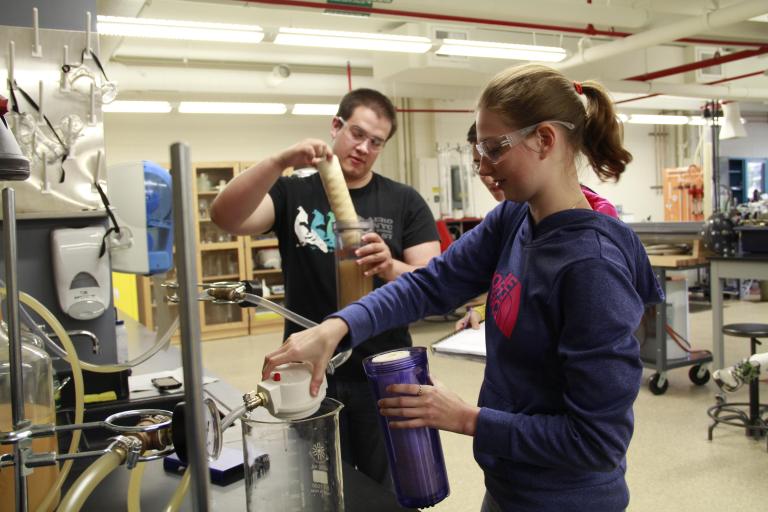
“What we’re giving them is the opportunity to find a process on their own.”
Dr. Jonathan Wenzel, Kettering University Chemical Engineering faculty member, wanted to incite creativity and collaboration during the filtration lesson in his Chemical Engineering lab so he unified the class around an ancient and universal nectar - beer.
“One of the reasons we went with beer for filtration is that I was trying to find something that could be easily replicated by other chemical engineering programs,” Wenzel said.
Wenzel hired a beer-making hobbyist, who is also a Kettering student, to brew the beer on campus. The beer was edible until the day of the experiment.
“It’s the same thing they’re doing at your local microbrewery or your home brewery,” Wenzel said. “You get a container, sterilize it, put in water and grain and boil to release the starches and sugars. Then you cool it down, put your yeast in and you seal it and let it do its business.”
The students’ task was not to drink the beer but instead filter out the yeasts in the lab. The catch: they weren’t given instructions or a step-by-step guide on how to perform the filtration.
“What we’re giving them is the opportunity to find a process on their own,” Wenzel said. “The whole goal of this project is to provide students the resources that they need to be able to go out and determine what might be the best approach to solving this problem.”
Chemical Engineering students were also encouraged to consult with microbiology students to enhance their knowledge of yeasts and potential contaminants in the filtration equipment. The long-term purpose of filtration is to remove the yeast and left over grain, then ultimately isolate the ethanol which has practical applications as a transportation fuel, additive in gasoline for pollution control and also the substance that makes beer fun to drink.
“Creativity is definitely part of the curriculum,” said Jennie Purdy ‘16, one of the three students participating in the beer filtration lab. “We’ve done more creative labs than even that one.”
Two professors from Villanova University were in attendance during the filtration lab as they searched for potential creative strategies and techniques that they could deploy in their own classrooms and laboratories.
"I am impressed by Kettering’s small class sizes and the interaction between the students and professors," said Dr. Justinus Satrio, Chemical Engineering professor at Villanova University.
This project was conducted in large part to the support of the Kern Entrepreneurial Engineering Network (KEEN). Wenzel, in partnership with Dr. Michelle Ammerman (Applied Biology), Dr. Steve Nartker (Chemical Engineering) and Dr. Cheryl Samaniego (Applied Biology) along with other distinguished faculty members in multiple departments at Kettering University have received about $40,000 each, for a total of $240,000 over the last two years, from KEEN to embed and incorporate various aspects of innovation and entrepreneurship mindset into their individual engineering and science courses. Additionally, Kettering granted six internal topical grants valued at $7,500 each to faculty who creatively infuse entrepreneurial elements in their classroom.
“It’s a lot different than looking at the book and their depiction of what’s going on and actually seeing it and how it applies to real life,” Wenzel said. “There are so many different things that you can do with these processes so it’s nice to have a hands-on visual process.”